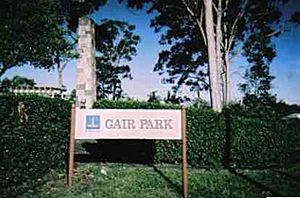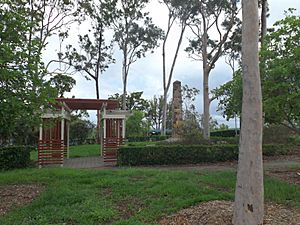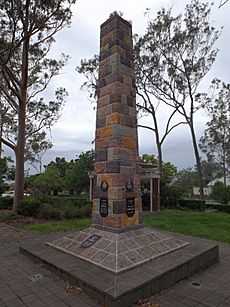Gair Park facts for kids
Quick facts for kids Gair Park |
|
|---|---|

Gair Park, 2009
|
|
| Location | 181 Annerley Road, Dutton Park, City of Brisbane, Queensland, Australia |
| Design period | 1919 - 1930s (interwar period) |
| Built | 1936 - |
| Official name: Gair Park | |
| Type | state heritage (landscape, built) |
| Designated | 5 April 2004 |
| Reference no. | 602429 |
| Significant period | 1930s-ongoing (fabric) 1936-ongoing (historical park use) 1951-ongoing (historical memorial use) |
| Significant components | seating, memorial - obelisk, memorial - plaque, trees/plantings, shed - shelter, tree groups - avenue of, fence/wall - perimeter |
| Lua error in Module:Location_map at line 420: attempt to index field 'wikibase' (a nil value). | |
Gair Park is a special park and memorial located at 181 Annerley Road in Dutton Park, Queensland, Australia. It was built starting in 1936. This park is so important that it was added to the Queensland Heritage Register on April 5, 2004. It's a place where people can relax and remember important events.
Discovering Gair Park's Past
Gair Park is a triangle-shaped piece of land where two main roads meet in Dutton Park. It was first developed as a park in 1936. After World War II, it became a "garden of remembrance" and a memorial. Today, it also honors people from other wars.
The area now called Dutton Park was once known as Bloggo or Boggo. It had many trees and deep valleys. A few farms were set up in the 1840s. But not many houses were built until the 1880s. More people started moving there as transport became easier.
A railway station opened in Dutton Park in 1884. The first horse-drawn bus service to Brisbane city began in 1890. Electric trams replaced the buses in 1908. After this, the area grew much faster. In 1914, the suburb was renamed Dutton Park. This was to honor Charles Boydell Dutton, who was a government official. By the late 1920s, Dutton Park was considered a popular place to live.
In 1929, a newspaper article praised Dutton Park. However, it also mentioned a problem area. This was the vacant triangle of land at the intersection of Annerley and Gladstone Roads. The article said it was "little more than a rubbish heap." It suggested it could be a "charming little tree shaded reserve."
Steps were taken to fix this in 1936. The land, which was part of the road, was given to the Brisbane City Council. It was then set aside as a park. Plans for the park were made in June 1936. In 1938, fifty trees were planted, helping the park grow.
The new park was named Gair Park. This was to honor Vincent (Vince) Clair Gair. He was a Labor Party member of Parliament for South Brisbane. Vince Gair was born in Rockhampton in 1901. He moved to Dutton Park with his family in 1916. His family was very involved in politics. He became the leader of the local Labor Party branch.
Gair was first elected to the Queensland Parliament in 1932. He became a government minister in 1942. He was the Minister for Labour and Employment from 1944 to 1950. In 1947, he became Deputy Premier. In 1950, he became Treasurer. He then became Queensland Premier in 1951. He helped introduce the 40-hour working week. He also updated laws about factories and shops.
Vince Gair lived in the local area until he passed away in 1980. He was always active in his community. He supported local groups, especially those helping with health and children's welfare.
After World War II, a local group wanted to build a Memorial Hall. The Brisbane City Council did not like this idea. Instead, they suggested using a part of Dutton Park. Another group, the Dutton Park sub-branch of the RSSAILA (now RSL), proposed developing Gair Park. They wanted to make it a Garden of Remembrance with a suitable memorial. This idea was approved.
Plans for the memorial were made in 1949. The memorial was an obelisk made of stone. It had bronze memorial tablets. It was placed on a base where wreaths could be laid. It was located at a corner of the park, on a small hill. You could reach it through a path lined with shrubs and hedges.
Hugh McKernan built the memorial. It was officially revealed on Anzac Day in 1951. Lieutenant-General Sir John Lavarack, the Governor of Queensland, unveiled it. For the local RSL members, this was a big achievement. It turned what was once an untidy piece of land into a beautiful place.
Before World War I, Australia had few public monuments. The memorials built after this war became our first national monuments. They showed the terrible impact of war on a young country. Australia lost 60,000 people from a population of about 4 million. This was one in five of those who served. No other war has had such a big impact. Most Australian war memorials are from this time.
Monuments built after World War II and later conflicts are less common. Many are additions to older memorials. Or they are practical projects, like public parks. Gair Park's memorial is a cenotaph (a monument to those buried elsewhere) in a Garden of Remembrance. It dates from World War II, making it a less common type in Queensland. Memorials for earlier and later conflicts have been added to it.
The park's design has become less formal over time. In 1954, a small concrete wall was built along Annerley Road. It had spaces for park seats. A new flowerbed was added in the Gladstone and Annerley Road corner. In the 1960s, a row of eucalypt trees replaced earlier plants. In 1973-74, the Multiple Sclerosis Society asked for tables and chairs. This was to encourage people from a nearby care home to use the park. The park now has a picnic area and several shelters.
Today, Gair Park is used for outdoor activities. These include recreation, cultural events, and learning. Ceremonies are held there on Anzac Day to honor those who died in wars.
What Gair Park Looks Like
Gair Park is a garden of remembrance with a cenotaph. It is a triangle-shaped piece of land. It is bordered by Annerley Road, Gladstone Road, and Maldon Street in Dutton Park. The park's ground is wavy and slopes down towards where the roads meet. The northeast corner has been changed to block access to Maldon Street from Annerley Road. A small side road has been cut to the south, connecting Gladstone Road and Annerley Road.
The main memorial is near the western corner of the park. It sits at the top of a grassy path. This path is lined with hedges and eucalypt trees. The memorial is an obelisk, which is a tall, four-sided, tapering stone pillar. It is about 20 feet (6 meters) high. It is made of square blocks of Brisbane tuff (a type of stone). It stands on a sloping base called a plinth, which is covered with stone tiles. A paved area surrounds the memorial.
Bronze memorial tablets are set low on the sides of the obelisk. These tablets have bronze laurel wreaths above them. They are inscribed with "In Memory of Fallen Comrades." Below this, the dates of the First and Second World Wars are listed. Also included are the Korean, Malaya, Vietnam, and Borneo conflicts. The fourth plaque remembers the memorial's dedication. It says it was "Unveiled by his Excellency the Governor of Queensland Lieutenant General Sir John Laverack KBE, CB, CMG, DSO and dedicated by Reverend A G Reilly on 25 April 1951."
On the plinth, there are more plaques. One says "Lest We Forget. Dutton Park sub branch RSSAILA." Another says "Lest We Forget. Yeronga, Dutton Park RSL Branch. Merged 3.2.1964." The park also has several park seats and wooden shelters. There are also scattered plants and trees.
Why Gair Park is Special
Gair Park was added to the Queensland Heritage Register on April 5, 2004. It met several important requirements.
It shows how Queensland's history has changed. Gair Park is a garden of remembrance and a cenotaph. It honors the war dead from the Dutton Park area. Memorials like this are important in Queensland towns and cities. They show how being involved in wars has shaped Queensland's history. They also show Australian pride and sense of nationhood. They reflect the public's feelings and social attitudes of their time.
It shows the main features of its type of cultural place. Many war memorials in Queensland were built after World War I. Gair Park is different because its garden and cenotaph were built after World War II. After this war, people often added to existing memorials. Or they built practical memorials, like public facilities. Gair Park is a good example of a cenotaph in a formal garden of remembrance.
It is beautiful to look at. Gair Park is important for its beauty. This includes both the parkland and the war memorial. The cenotaph is placed dramatically at the top of a grassy slope. It rises above Annerley Road at a major road intersection. This makes it a well-known landmark in the area.
It has a strong connection with the community. Gair Park and its memorial have a strong connection with the Dutton Park community. It shows how a major historical event affected the area. It was also a big project for the local RSL branch. It is an important place for ceremonies and recreation.
It is linked to an important person in Queensland's history. Gair Park is connected to the life and work of former Queensland Premier, Vincent Clair Gair (1902–1980). Naming the park after him recognizes his strong support for the area. He was the Member of the Legislative Assembly for South Brisbane.



